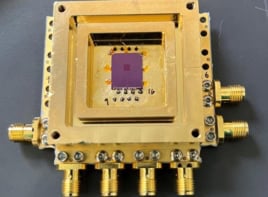NB: The publication on which this article is based has been retracted by its authors. The retraction followed an investigation into scientific misconduct by J Hendrik Schön. We are leaving this article here for archival purposes. Further information can be found at http://physicsweb.org/article/news/6/9/15
Physicists have achieved superconductivity in carbon-60 at 54 K - the highest temperature yet in the material - and they think they can do even better. Bertram Batlogg and co-workers at Bell Laboratories in the US broke the record by adding positive charges - instead of electrons - to carbon-60 crystals. They believe this is the highest superconducting temperature attained so far in a non-copper-oxide material (J H Schon et al 2000 Nature 408 549).
Carbon-60 is in a class of organic materials known as fullerenes, which are insulators. Scientists first generated superconductivity – current flow without resistance below a certain ‘transition temperature’ – in carbon-60 ten years ago. They doped the material with alkali metal ions, which donate its electrons and makes the carbon-60 conducting. But electron doping led to a maximum transition temperature of only 40 K. Researchers believed that adding positive charges, known as positive holes, to carbon-60 might lead to a higher transition temperature. But carbon-60 is very electronegative – that is, it strongly repels positive charges – and this makes it very difficult to add positive holes by conventional doping.
Batlogg and co-workers overcame the problem with a completely different method. They deposited electrodes onto a carbon-60 crystal to form a field-effect transistor, and applied a voltage across it that forced positive holes into the crystal. The team found that the transition temperature varied smoothly with changing voltage, peaking at 54 K.
The superconducting behaviour of hole-doped carbon-60 is expected to be similar to that in electron-doped carbon-60. In electron-doped carbon-60, the addition of alkali metal ions stretches the crystal lattice and makes the transition temperature rise. Batlogg’s team predicts that the transition temperature could reach 100 K if they can add impurities to the hole-doped carbon-60.
The phenomenon observed by Batlogg’s team has much in common with early superconductivity observations. Superconductivity in carbon-60 is thought to originate from interactions between electrons and lattice vibrations known as phonons – this mechanism was proposed in 1957 by Bardeen, Cooper and Schrieffer. This is fundamentally different to the process that takes place in modern copper-oxide-based superconductors, which relies on interactions between only electrons.



